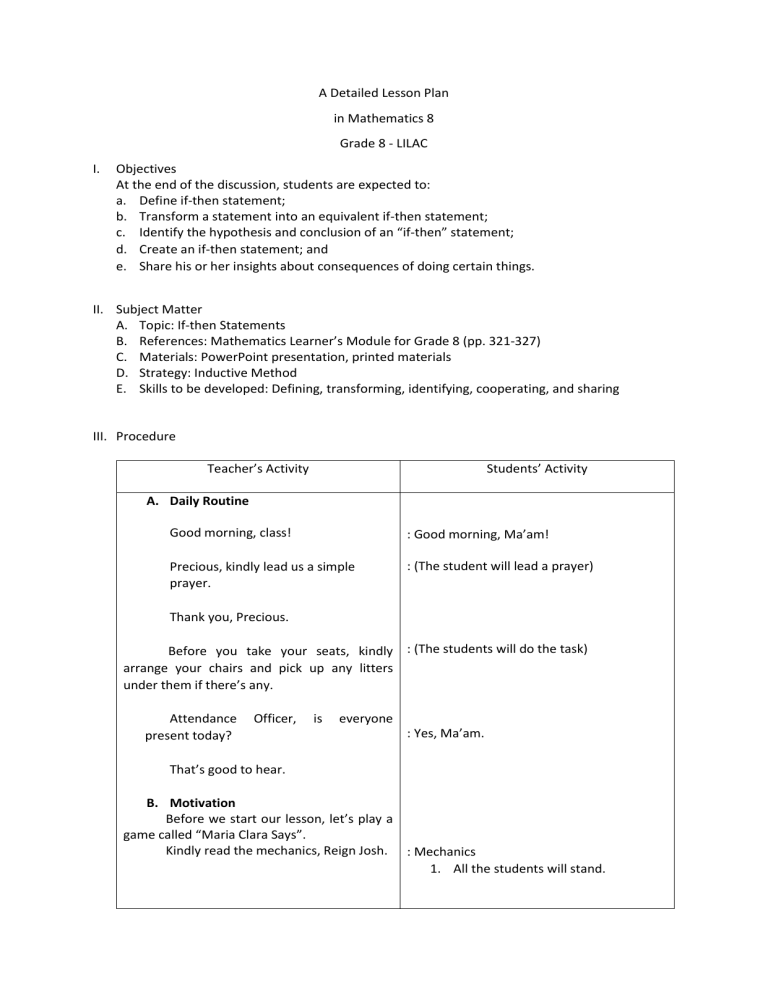
A Detailed Lesson Plan in Mathematics 8 Grade 8 - LILAC I. Objectives At the end of the discussion, students are expected to: a. Define if-then statement; b. Transform a statement into an equivalent if-then statement; c. Identify the hypothesis and conclusion of an “if-then” statement; d. Create an if-then statement; and e. Share his or her insights about consequences of doing certain things. II. Subject Matter A. Topic: If-then Statements B. References: Mathematics Learner’s Module for Grade 8 (pp. 321-327) C. Materials: PowerPoint presentation, printed materials D. Strategy: Inductive Method E. Skills to be developed: Defining, transforming, identifying, cooperating, and sharing III. Procedure Teacher’s Activity Students’ Activity A. Daily Routine Good morning, class! : Good morning, Ma’am! Precious, kindly lead us a simple prayer. : (The student will lead a prayer) Thank you, Precious. Before you take your seats, kindly : (The students will do the task) arrange your chairs and pick up any litters under them if there’s any. Attendance present today? Officer, is everyone : Yes, Ma’am. That’s good to hear. B. Motivation Before we start our lesson, let’s play a game called “Maria Clara Says”. Kindly read the mechanics, Reign Josh. : Mechanics 1. All the students will stand. 2. The teacher will flash different statements that the students need to follow. 3. The students will remain standing if the statement fits to them, otherwise sit down. 4. The student who remains standing will be given 5,000 pesos. Thank you, Reign Josh! Is the mechanics clear, class? Are you ready? : Yes, Ma’am. If so, let’s now begin. 1.IF you are from section Lilac, THEN raise your right hand. 2.IF you play mobile legends, THEN stomp your feet thrice. 3. IF your age is 13, THEN raise your left hand. 4. IF your weight is greater than 35, THEN snap your fingers twice. 5. IF the month of your birthday ends with a ‘BER’, THEN clap your hands. 6. IF your name starts with letter ‘H’, THEN give me a thumbs up. Congratulations, Hans! C. Presentation of the Lesson Let’s go back to the different statements we had a while ago. What have you noticed? : There are common words like if and then. That’s right! As we can see, there are ifs and thens in every statement and that will be our main focus for today, IF-THEN STATEMENTS. D. Lesson Proper What is all about if-then statements? Kindly read the definition, Cielo. Thank you! : Also known as Conditional Statement. An if-then statement is composed of two clauses: the if-clause and the then-clause. We can denote a letter for each clause, p for the if-clause and q for the then clause. The statement is in the form, "If p then q." Conditional statements are formed by joining two statements p and q using the words if and then. The p statement is called the hypothesis and the q statement is called the conclusion. The hypothesis is the part of a conditional statement that follows “if” The conclusion is the part of a conditional statement that follows “then”. For deeper understanding, let’s have an example. Kindly read, Rendel. : If you clean your room, then you can play outside the house. Thank you! What do you think is our p or hypothesis? : You clean your room Very Good! What is our q or conclusion? : You can play outside the house. That’s right! Let’s have another example. Kindly read, Allieyah. : If you are an Ilocano then you are friendly. Correct! Who would like to identify the p or hypothesis? Yes, Christian? : You are an Ilocano Who would like to identify the q or conclusion? Yes, Wilfred? : You are friendly Very Good! If today is Thursday, then tomorrow is Friday. If you do your chores all week, then you can get your allowance. Is identifying the hypothesis and conclusion clear to you, class? : Hypothesis: Today is Thursday Conclusion: Tomorrow is Friday. : p: You do your chores all week q: You can get your allowance. : Yes, Ma’am! That’s good to know! Mind you class, there are some conditional statements not written in this form but you can rewrite them using the if-then form. How are we going to identify the hypothesis and conclusion if we have this kind of statement. Igorots are artistic. : If you are an Igorot then you are artistic. Guitar players are musicians. : If you are a guitar player then you are a musician. All right angles are congruent. : If all the angles are right then they are congruent. Is there any question with regards to transforming statement into if-then form? : None, Ma’am. Very Good, Class! E. Application It seems like you have really understood our lesson. And now, let’s have an activity entitled, “She Knows and I Know She Knows”. Before we start, kindly read the mechanics, Haveron. : Mechanics: 1. The class will be divided into four groups. 2. Each group will receive an envelope that contains different illustrations. 3. Each group needs to create if-then statements using those illustrations. 4. One representative will present their output. Note! The reporter/representative will receive 5, 000 pesos and the best group will receive 3,000 pesos each. Is the mechanics clear to you class? : Yes, Ma’am. Well then, you may now start. : (The students will present their output) F. Valuing (The photos/statements used in previous activity will serve as guide) Always remember that if you give importance to your studies then you will surely achieve your dream career. G. Generalization What is the other term for if-then : Conditional Statement statement? A statement is composed of two : If-clause and then clause clauses, what are these? The if clause is called? The then clause : Hypothesis and conclusion. is? What letters are used to represent : p is for hypothesis and q for conclusion. hypothesis and conclusion? Very good, class! Seems like you really understood our lesson. IV. Evaluation Convert each statement to if-then form, then underline the hypothesis and encircle the conclusion. 1. Good citizens obey rules and regulations. 2. Filipinos are God-fearing people. 3. Studying hard gets high grades. 4. An honest student does not cheat during an examination. 5. You are safe if you are vaccinated. V. Assignment Identify the hypothesis and conclusion in the following statements. 1. If a polynomial has six sides, then it has three angles. 2. If 3x = 24, then x = 8. Convert each statement to if-then form, then identify the hypothesis and the conclusion. 3. Triangle has three angles. 4. An eighteen-year-old Filipino can cast his/her vote during election. 5. National Disaster Risk Reduction Council volunteers are busy during calamities.



